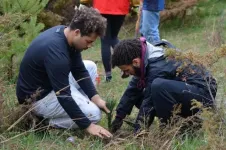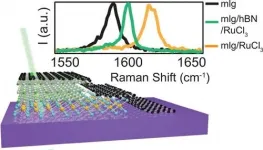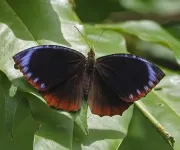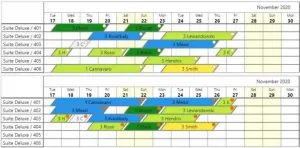Mapping out our own small pocket of the Universe is a time-honored quest within astronomy, and the results announced today have added to this long-running effort by cataloging the locations of more than 500 cool brown dwarfs in the vicinity of the Sun. An international team of astronomers -- assisted by the legions of volunteer citizen scientists in the Backyard Worlds: Planet 9 collaboration -- have announced an unprecedented census of 525 cool brown dwarfs within 65 light-years of the Sun, including 38 new discoveries. By determining the distances to all the objects in the census, astronomers have been able to build a 3D map of the distribution of cool brown dwarfs in the Sun's local neighborhood.
This breakthrough relied on novel datasets published by the DESI Legacy Imaging Surveys, which blend huge quantities of astronomical data from a variety of sources: archival images from the Nicholas U. Mayall 4-meter Telescope at Kitt Peak National Observatory (KPNO) and the Víctor M. Blanco 4-meter Telescope at Cerro Tololo Inter-American Observatory (CTIO), which are Programs of NSF's NOIRLab, plus critical sky maps from NASA's Wide-field Infrared Survey Explorer (WISE). These powerful survey datasets were combined with new distance measurements from the NASA Spitzer Space Telescope to create the best three-dimensional map of the Sun's local neighborhood to date.
Brown dwarfs are sometimes referred to as "failed stars." They are thought to form the way stars do, but they do not become massive enough to trigger nuclear fusion in their cores. Their faintness and relatively small sizes make them difficult to identify without careful analysis of data from sensitive telescopes -- meaning that many have gone undiscovered until now. However, by finding and studying brown dwarfs, astronomers can learn more about star formation and also about planets around other stars.
"Brown dwarfs are the low-mass byproducts of the process that forms stars, yet the least massive of them have many characteristics in common with exoplanets," says J. Davy Kirkpatrick, California Institute of Technology scientist and lead author of the research paper. "They're exoplanet laboratories, but since they are usually by themselves and lack the complications caused by a blinding host sun, they're much easier to study."
To help identify elusive brown dwarfs in massive datasets, astronomers enlisted the help of the Backyard Worlds collaboration, a worldwide network of more than 100,000 citizen scientists.[1] Astro Data Lab at NOIRLab's Community Science and Data Center (CSDC) was instrumental in providing these volunteers with data, allowing citizen scientists to easily hunt through the astronomical archives in search of brown dwarf candidates. The Backyards Worlds project announced the discovery of almost 100 nearby cool brown dwarfs in August last year, and today's announcement is a continuation of their work.
"The Backyard Worlds project shows that the general public can play an important role in cutting-edge astronomy," commented NOIRLab scientist Aaron Meisner, co-author of this study and co-founder of Backyard Worlds. "Volunteers ranging from high school students to retired engineers are helping uncover groundbreaking discoveries lurking in existing telescope data."
One of the most intriguing results of this study is that it provides more evidence that the Sun's immediate neighborhood (within roughly 7 light-years) is rather unusual. While most stars in the Milky Way are red dwarfs, earlier results revealed that the Sun's closest neighbors are much more diverse, with different types of objects, from Sun-like stars to Jupiter-like brown dwarfs, appearing in roughly equal numbers.[2] The new results add to this disparity by turning up no more extremely cold brown dwarfs like our close-by neighbor WISE 0855, the coldest known brown dwarf, even though the team expected to find at least several more within 65 light-years of the Sun, given the new study's sensitivity.
This result hints at the possibility that yet more cold brown dwarfs have so far eluded detection. "Thanks to the efforts of volunteers around the world, we have a better idea than ever of the objects in our cosmic backyard," concluded Meisner. "But we suspect that more of the Sun's cold and close neighbors still await discovery within our vast data archives."
INFORMATION:
Notes
[1] Backyard Worlds: Planet 9 is hosted by Zooniverse.
[2] Stars and brown dwarfs are classified by their temperature and other spectral characteristics using letters of the alphabet. For example, our Sun is a G star, a K star is considered an orange dwarf star, and M stars are often called "red dwarfs," while brown dwarfs are classified as L, T, and Y dwarfs. Earlier studies have revealed that, collectively, the four nearest star systems to the Sun include one G-dwarf star, one K dwarf, two M dwarfs, one L dwarf, one T dwarf, and one Y dwarf.
More information
This research was presented in the paper The Field Substellar Mass Function Based on the Full-sky 20-pc Census of 525 L, T, and Y Dwarfs to appear in The Astrophysical Journal Supplement.
The team is composed of J. Davy Kirkpatrick (California Institute of Technology), Christopher R. Gelino (California Institute of Technology), Jacqueline K. Faherty (American Museum of Natural History), Aaron M. Meisner (NSF's NOIRLab), Dan Caselden (Gigamon Applied Threat Research), Adam C. Schneider (US Naval Observatory, George Mason University), Federico Marocco (California Institute of Technology), Alfred J. Cayago (University of California Riverside), R. L. Smart (Istituto Nazionale di Astrofisica, Italy), Peter R. Eisenhardt (Jet Propulsion Laboratory), Marc J. Kuchner (NASA Goddard Space Flight Center), Edward L. Wright (University of California Los Angeles), Michael C. Cushing (University of Toledo), Katelyn N. Allers (Bucknell University), Daniella C. Bardalez Gagliuffi (American Museum of Natural History), Adam J. Burgasser (University of California, San Diego), Jonathan Gagné (Université de Montréal, Canada), Sarah E. Logsdon (NSF's NOIRLab), Emily C. Martin (University of California, Santa Cruz), James G. Ingalls (California Institute of Technology), Patrick J. Lowrance (California Institute of Technology), Ellianna S. Abrahams (University of California, Berkeley), Christian Aganze (University of California, San Diego), Roman Gerasimov (University of California, San Diego), Eileen C. Gonzales (Cornell University), Chih-Chun Hsu (University of California, San Diego), Nikita Kamraj (California Institute of Technology), Rocio Kiman, (American Museum of Natural History and City University of New York), Jon Rees (University of California, San Diego), Christopher Theissen (University of California, San Diego), Kareem Ammar (Pasadena Polytechnic School), Nikolaj Stevnbak Andersen (Sygehus Lillebalt, Denmark), Paul Beaulieu (Backyard Worlds: Planet 9), Guillaume Colin (Backyard Worlds: Planet 9), Charles A. Elachi (St. Francis High School), Samuel J. Goodman (Backyard Worlds: Planet 9), Léopold Gramaize (Backyard Worlds: Planet 9), Leslie K. Hamlet (Backyard Worlds: Planet 9), Justin Hong (Pasadena High School), Alexander Jonkeren (Backyard Worlds: Planet 9), Mohammed Khalil (Lebanon International College and Stanford University), David W. Martin (Backyard Worlds: Planet 9), William Pendrill (Backyard Worlds: Planet 9), Benjamin Pumphrey (Augusta Psychological Associates), Austin Rothermich (University of Central Florida), Arttu Sainio (Backyard Worlds: Planet 9), Andres Stenner (Backyard Worlds: Planet 9), Christopher Tanner (Backyard Worlds: Planet 9), Melina Thévenot (Backyard Worlds: Planet 9), Nikita V. Voloshin (Backyard Worlds: Planet 9), Jim Walla (Backyard Worlds: Planet 9), Zbigniew Wedracki (Backyard Worlds: Planet 9), and the Backyard Worlds: Planet 9 Collaboration.
NSF's NOIRLab (National Optical-Infrared Astronomy Research Laboratory), the US center for ground-based optical-infrared astronomy, operates the international Gemini Observatory (a facility of NSF, NRC-Canada, ANID-Chile, MCTIC-Brazil, MINCyT-Argentina, and KASI-Republic of Korea), Kitt Peak National Observatory (KPNO), Cerro Tololo Inter-American Observatory (CTIO), the Community Science and Data Center (CSDC), and Vera C. Rubin Observatory. It is managed by the Association of Universities for Research in Astronomy (AURA) under a cooperative agreement with NSF and is headquartered in Tucson, Arizona. The astronomical community is honored to have the opportunity to conduct astronomical research on Iolkam Du'ag (Kitt Peak) in Arizona, on Maunakea in Hawai?i, and on Cerro Tololo and Cerro Pachón in Chile. We recognize and acknowledge the very significant cultural role and reverence that these sites have to the Tohono O'odham Nation, to the Native Hawaiian community, and to the local communities in Chile, respectively.
Links
Research paper
2020 Press Release: Cool New Worlds Found in Our
Cosmic Backyard
Blog Post: WISE Infrared Sky Maps for the DESI
Legacy Imaging Surveys
NASA Press Release
Contacts
Aaron Meisner
Astronomer at NSF's NOIRLab
Cell: +1 650 714 8643
Email: aaron.meisner@noirlab.edu
Amanda Kocz
Press and Internal Communications Officer
NSF's NOIRLab
Cell: +1 626 524 5884
Email: amanda.kocz@noirlab.edu




